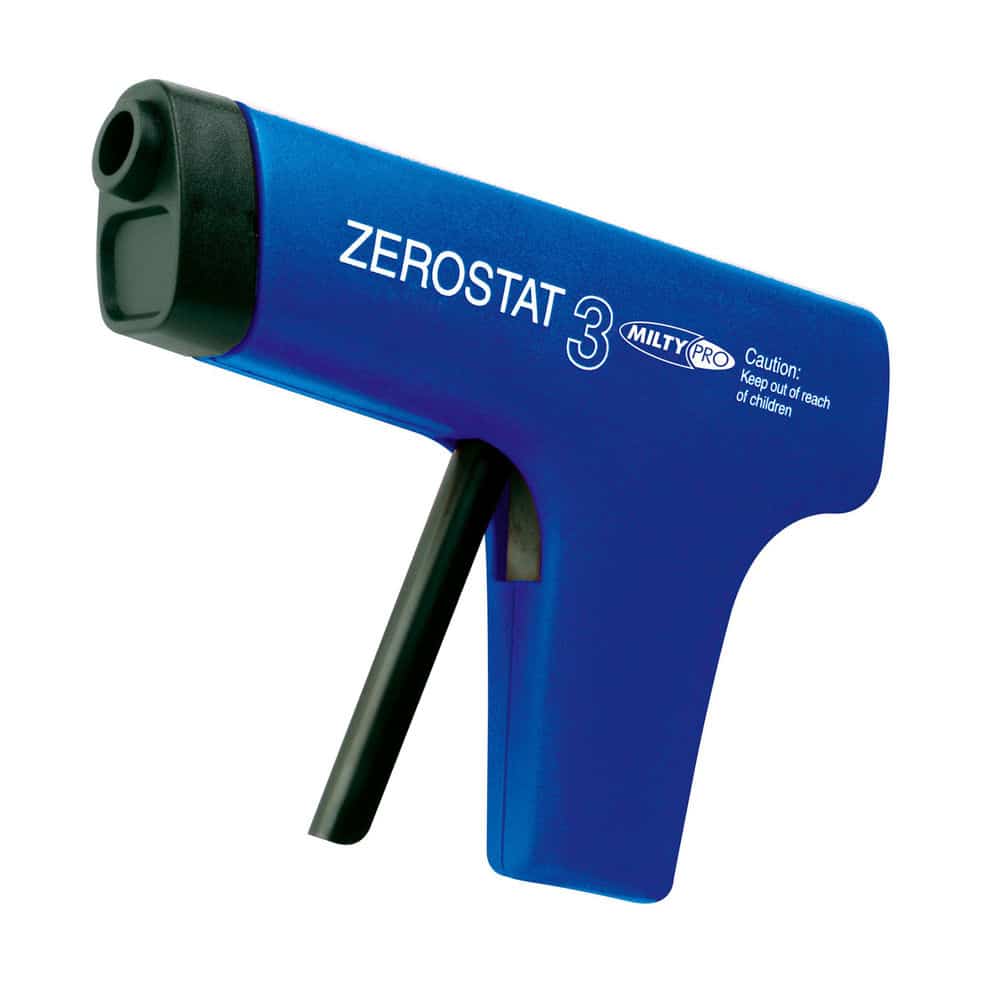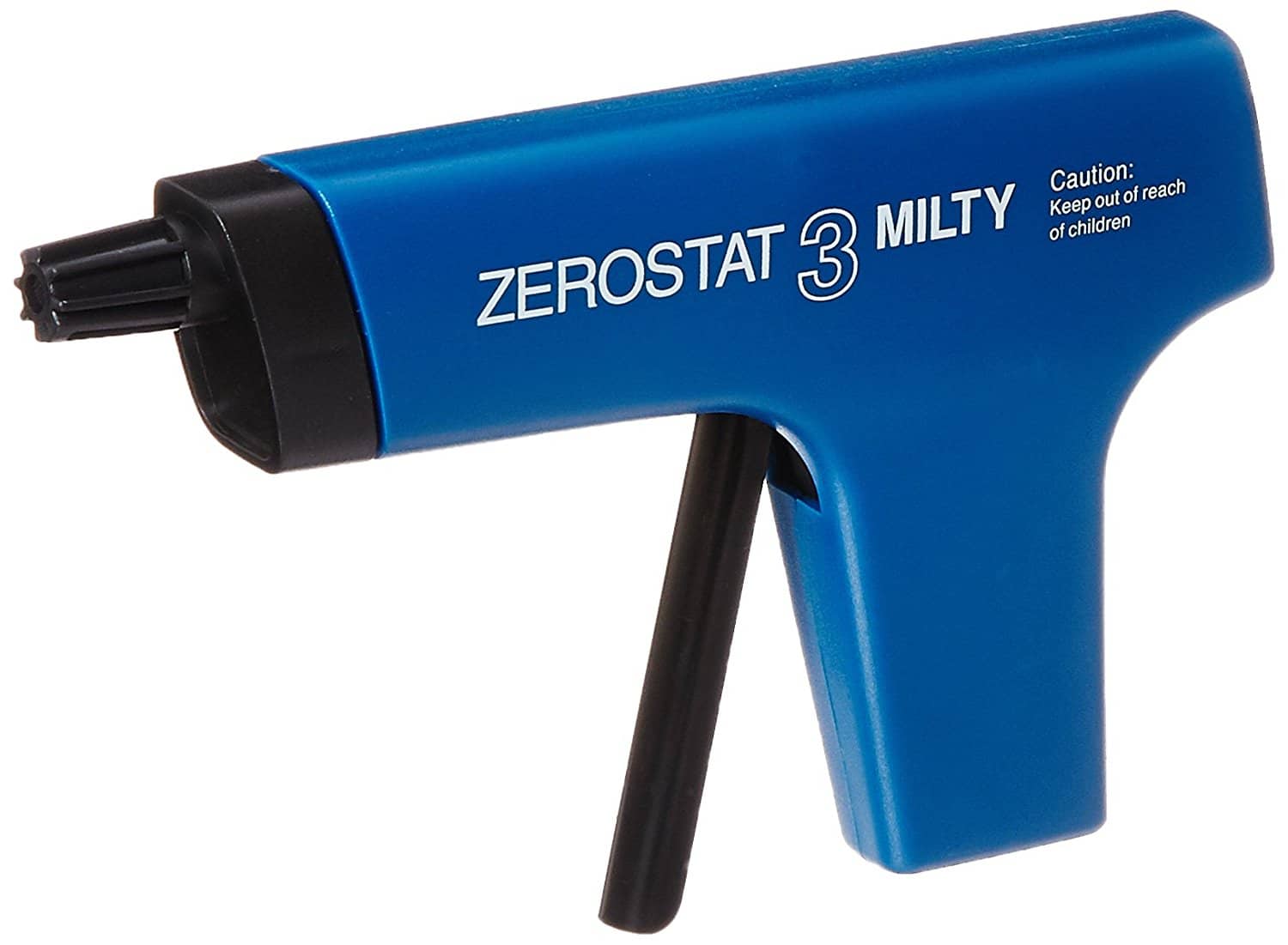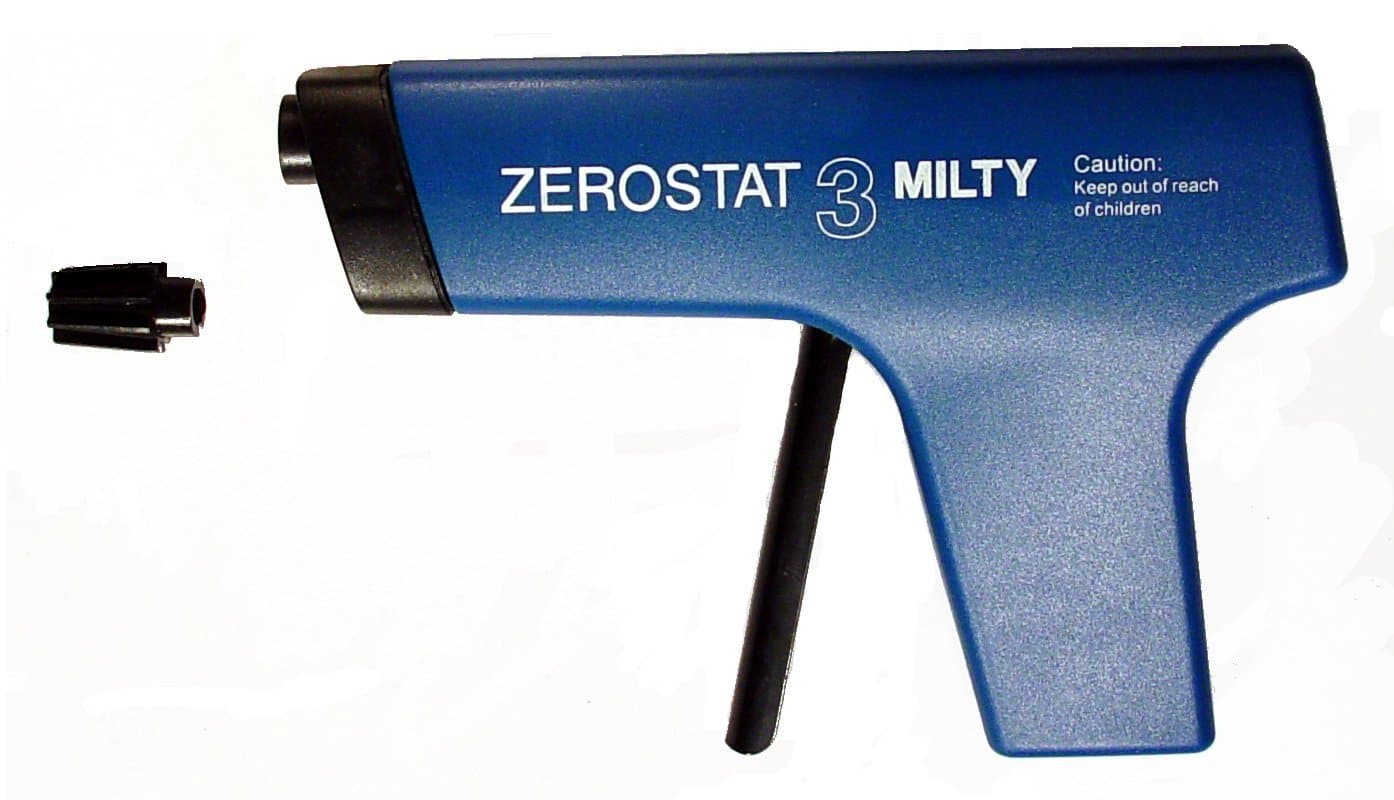The Article
MILTY ZEROSTAT 3: Lower Static and Dump Your Dust
26th August 2017

Milty intends it to be part of your vinyl care routine, Paul Rigby reviews its Zerostat 3 and tests its effectiveness as an anti-static tool
I will always be grateful to my parents. I must have been 14 when I received my first hi-fi. We were pretty poor so any new hi-fi was a major deal. It was a Technics SL-B2 turntable and Grado cartridge, Denyo AU3000M integrated amp (anyone remember that one?), JVC KC33 cassette deck, Wharfedale Shelton speakers (whose tweeters would regularly blow because I pushed them too hard), QED stands and 79-strand cable. Vinyl care was handled by a Milty Pixall Roller (the larger barrelled Mk.1 then the relatively svelte Mk.II) and…a Zerostat. The roller to pick up the hardcore grime and the Zerostat to remove static.
I was a convert back when I was 14, I am now.
Many were not and are still not.
Hi-fi, like any hobby or interest, is full of different people with differing views and beliefs. Many of whom disagree with each on various points, often with a passion. Take the subject of cables, as one prime example and point of diverse opinion.
Often, the problem is a lack of action on the part of the product. When a piece of hi-fi kit is bereft of buttons, flashing lights and aural feedback, suspicion is laid upon it. Is it actually doing anything at all?
The Zerostat has often fallen into the same sort of category. OK, it has that John Wayne-esque shape which appeals to the boy in all of us – even some of you ladies, I hear – and there is a moving part, that trigger but, well, nothing emerges from the barrel. No laser-like stream hits the vinyl. Your vinyl record doesn’t shudder with the forceful impact of ions. There’s no fireworks. There’s no pizazz.
IN USE
So, what exactly is it? The Zerostat 3 is a gun-shaped device set in moulded hard plastic that produces a combination of positive and then negative ions at the ‘target’. The idea is too neutralise the area of static charge, the thing that attracts dust to the area. The intended prime target being your vinyl records.
In action, you point the gun at your vinyl, point it at the spindle hole to give the ions an even spread. Hold the gun about 12 inches from the centre of the record and gently – and I mean gently – squeeze the trigger. Just like Dirty Harry taught you too, all those years ago. Then, when you can’t go any further, maintain the gun’s position and slowly release the trigger. If you’re too impatient, the Zerostat will emanate a cracking sound which reduces efficiency. If you’re doing that, then stop and start again. Otherwise, you’re wasting your time.
Some people talk about pulling the gun away from the record during the trigger release stage but I find no advantage in this practice. In fact, if you want to neutralise a single area, I would have thought keeping the tool at the steady distance would encourage an even application, one that will receive both positive and neutral ions in equal quantity.
That’s it, there’s no batteries, no power supply. The Zerostat is a stand-alone device. Milty says that the Zerostrat should last for around 50,000 trigger operations. Hence, this tool will remain useful for many years, if not decades.
FOR MY NEXT TRICK…!
If you’re suspicious that the Zerostat is doing nothing and Milty is merely serving you a con wrapped in formed hard plastic, then you can perform your own experiment even before you get anywhere near a record to prove that this thing is actually for real. Milty does supply a nozzle which, when attached, lights up when the Zerostat is in use – well, it tends to light up when the device makes that cracking sound, actually. There is a better experiment to try, though.
When you open the box for the Zerostat, don’t throw away the shrink wrap. Keep it to hand. Literally. Take the wrap in the palm of your hand and place it against your clothing or a passing dog or cat. Rub vigorously for a few seconds or long enough so that, when you lift your hand from your clothes, the wrap sticks to your hand through static electricity.
Position your hand horizontally, so that the wrap is sticking underneath your palm, your hand uppermost.
Take the Zerostat 3 in the other hand (make sure that nozzle I mentioned is off the Zerostat). Position the gun it underneath, several inches from your hand, so that it is pointing at the shrink wrap. Slowly press the trigger so that it doesn’t make a cracking noise. Then slowly release it, again not too fast or it will sound a crack and lose efficiency.
Then, behold! See the shrink wrap disconnect from the palm of your hand, as the static is lowered, and fall to the ground.
It could even be an act, folks. Call yourself Technology Magic Man! Weddings, bar mitzvahs and hi-fi clubs… You could even <ahem> charge for it.
You see? It does actually work. This little beauty actually removes static. The implications are enormous. That is, with regular use, dust will not follow your LPs like an airborne stalker, infiltrating its grooves and creating noisy playback.
Now, there’s a caveat to all of this. While everyone will benefit from a Zerostat, some people will see greater value for money if they live in a house with drying air or if their listening room is in a bedroom environment where dust is prevalent. Everyone will see some benefits, though.
Specifically? Have you ever taken a record out of a sleeve and heard multiple cracks from static as the LP emerged? This means that your LP is covered in static electricity and is currently attracting dust to its grooves, inside the sleeve, when it hits open air, when you put it on the turntable and while it’s playing. The result is more noise during play and, because dust abrades, that dust will increase wear and tear on the vinyl itself. In a tiny way, sure, but it will happen and, over time, will hasten your record’s demise.
A Zerostat will help that issue. Use the gun on the vinyl before you clean your vinyl (or after, depending on what cleaning tools you use) and again before you place the record back in the sleeve to reduce this issue. I used the Zerostat 3 on both occasions and noticed a reduction in crackles during play but also no static when the record was placed in the sleeve, no ‘inner-sleeve-clinging-for-dear-life-to-the-surface-of-the-record-type’ action.

CONCLUSION
The Zerostat 3 is not too badly priced for an accessory (ignore the official price tag below, I’ve seen it for sale for around £46, online via Amazon) which should figure in the daily life of your vinyl play experience. Also, if you average out the cost by its decades-length life span, then the price disappears into low, low fractions of a penny per use. Used in conjunction with a record cleaner, the Zerostat 3 will not only provide a more pleasant vinyl listening experience, it will extend the life of your precious records. A good thing, by anyone’s standards.
MILTY ZEROSTAT 3
Price: £60
Tel: 01279 501111
Website: shop.armourhome.co.uk
TO BUY CLICK BELOW:
USA – https://amzn.to/3kR9SKK
EUROPE – https://amzn.to/3oSbbLG
GOOD: easy to use, simple design, long life, [real world] price, performance
BAD: nothing
RATING: 8





There must be warehouses full of them,since the advent of the CD.
Brilliant demystifying review Paul, one we all needed as there’s so much nonsense spoken about static. I will definitely be investing in one as I’m one of those people who gets a shock every time I touch something which, in its way is a good thing, simply because it enabled me to locate an earth problem in our first house ie the earth cable wasn’t connected! Once that was sorted my static issues were minimised by almost 90 %.
One question : I use a velvet pad for gently swiping the vinyl before play. Does this mean I use the gun after the swipe and not before?
Here’s a real life cautionary tale that happened me. I’ll keep it as brief as possible.
Only a year ago I invested in a fantastic cartridge (Nagaoka MP110) which really impressed me. After a few months of usage I bought another ‘spare’ as I was sure this was my cartridge for life. Yep, that good. Then out of the blue the bangs started, while the record was playing! Bang, bang, bang…..every half hour or so. Using my own common sense and expert advice from other experts I tried literally everything re: earthing, trying out the spareetc etc to no avail. In the end it turned out that the cartridge was the culprit and not the arm/turntable combination! When I reinstalled my other cartridge (Goldring 1006) the problems immediately disappeared. I was very much taken aback by this upsetting experience as I’ve been into hi fi nearly 40 years now and I’ve never experienced anything like it. I still have the offending cartridge and it’s spare in the hope that one day I’ll have come up with a solution.
So the obvious question is : would the Zerostat solve the problem?
Conundrums? Don’t you just love them!
Thanks Dermot, very kind of you.
I would use the gun after the swipe, then you’re sure of all the static being removed.
Re the cart problems. I would venture to say that the gun is not the solution. Can I ask, did your ‘spare’ suffer from the same issues? Might be a construction issue. If the spare has no issues, then you’ll know for sure.
Thanks for the tip Paul.
Re: Cartridge problem: Unbelievabley my ‘spare’ suffered from exactly the same issues on two different arms. The only common factor was that both arms were made of carbon fibre – a Wand plus and my current arm, an Ace Space. Even so I did run an extra earth wire from the metal headshell to ground to no avail. All the usual earthing conditions were met plus an extra earth from beneath the platter bearing AND another earth point from the arm collet. Believe me I tried everything…..
But one thing that did intrigue me when I examined the cartridge more closely and removed the stylus assembly was the fact that I noticed this crude blob of a very strong magnet attached to the front body; this then means that it’s only mere mm’s from the record whilst playing. Do you follow me? Surely that can’t be an ideal set up? Definitely not in my system anyway. Finally just so you know I did test the cartridges myself with the old meter and also sent it back to the online shop I bought it from for further testing. Both cartridges were perfect.
Work that one out!
Very odd Dermot! Certainly a new one on me for that cart.
Paul – the Zerostat has been around since the 70s and was marketed by Discwasher (in Canada) back then – it was red. It’s tried and true. I had one back then – long gone. I may replace it. But it’s over $100 Canadian on Amazon.ca right now, so …. not yet!
Yes, I had the red one too 🙂 Quite a high price compared to the UK, though.
It’s an old topic, but having had this problem myself, I will add my comments for anyone else finding this page. I have an original lZerostat that is still working after 40 years. The occasional “bangs” every half hour or so are caused by the discharge of static from the charged record surface via the cartridge assembly. It’s like a miniature lightning strike from the vinly to the tone arm. Adding extra earthing to the cartridge was just adding to the problem. The process of playing the record with the diamond stylus can generate a static charge. If all static is neutralised by the Zerostat before playing then you have a head start on eliminating the problem. If you are playing your vinyl in a low humidity environment this will also add to the problem, as a reasonable humidity level allows the static to discharge naturally into the humid air.
Hello Paul
Perhaps silly question but I understand that the measurements indicates lower statics and you find the sound better after a treatment but do the clicks and pops go away with Zerostat? Or would you say they are MAINLY due to other reasons. If so which?
/Rutger
Hi Rutger – that depends on the vinyl. Clicks and pops created as a result of static did go away yes. Other clicks and pops might be there because of surface damage or they might be due to baked on dirt requiring cleaning.
Hello Paul
If you would just give me a hint of your experience from vinyls bought second hand. How would you rank them in order of likelyhood From most likely to least likely of the three causes you mention. (I am not asking for a scientificly correct answer of course but rather a qualified estimate/guess from your experience)
Thanks
Rutger
It’s impossible to rank second-hand vinyl in terms of condition, Rutger. It depends on the ‘from new’ condition, how they were stored and maintained and the owner him/herself. And the owner also introduces several other variables (i.e. where exactly did they store the vinyl, did they smoke, did they place their fingers on the vinyl surface, etc.)
Each second hand disc offers its own history to you when you meet it.
When I say “It‚Äôs impossible to rank second-hand vinyl in terms of condition” I obviously mean, until you get your hands on it and examine it closely.